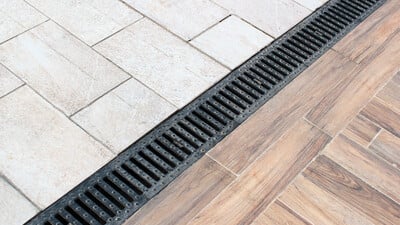Managing surface water on industrial sites is a critical challenge. These environments often feature large, flat, non-porous surfaces such as loading bays, vehicle parking areas and factory floors. Without proper drainage, heavy rainfall can lead to flooding, operational delays and long-term damage to infrastructure.
Channel drains, also known as linear or trench drains, provide an efficient solution by rapidly collecting and directing surface water away from these areas.
In this blog post, we discuss the construction, materials and load ratings of channel drains, with a particular focus on industrial applications.
What Are Channel Drains?
Channel drains are long, open-topped gullies covered by a grating that sits flush with the surrounding surface. Designed to manage surface water efficiently, they direct it to underground pipework for safe disposal.
Unlike single-point gully drains, which require water to be directed to a smaller area, channel drains collect water along their entire length, making them ideal for rapidly draining large areas.
How Do Channel Drains Work?
Channel drains are typically installed with a slight slope to encourage water flow. Depending on the site requirements, they may feature a uniform depth or an inbuilt incline for faster drainage. The grating, often removable, prevents debris from clogging the channel while allowing easy maintenance.
Materials Used in Channel Drains
The choice of materials for channel drains and their covers is crucial to their performance and durability.
Channel drains are typically manufactured in one of four materials:
Polymer Concrete
A composite of resin and aggregates, offering excellent strength and chemical resistance. Suitable for moderate to heavy loads, such as car parks and light industrial zones.
Concrete
Durable and cost-effective, often used in public infrastructure and heavy-duty industrial applications.
High-Density Polyethylene (HDPE)
Lightweight and UV-resistant, suitable for light to medium loads.
Stainless Steel
Corrosion-resistant and hygienic, ideal for environments like food processing plants.
HDPE and stainless steel channels are frequently chosen for industrial environments where harsh chemicals may be present or hygiene standards must be met.
Channel drain covers are also made from a variety of materials:
Ductile Iron
Extremely strong and capable of withstanding heavy loads, making it suitable for industrial zones.
Galvanised Steel
Durable and rust-resistant, often used in car parks and light industrial settings.
Plastic
Lightweight and cost-effective, used in pedestrian areas and light-duty applications.
Load Ratings for Industrial Applications
Load ratings for channel drains are standardised under BS EN 124:2015, ensuring they meet specific weight-bearing requirements. For industrial sites, the following ratings are most relevant:
D400 (40 Tonnes)
Ideal for areas with heavy traffic, including public car parks, loading bays, and light industrial zones.
E600 (60 Tonnes)
Designed for industrial estates and sites with heavy forklifts or materials-handling equipment.
F900 (90 Tonnes)
Used in the most demanding environments, such as airports and dockyards, where extremely heavy loads are common.
Choosing the correct load rating is vital to prevent damage and ensure compliance with regulations.
Benefits of Channel Drains on Industrial Sites
Rapid Water Removal
Channel drains excel at quickly removing surface water from large, non-porous areas, reducing the risk of flooding and operational delays.
Enhanced Safety
By preventing standing water, channel drains reduce the risk of slips, trips and vehicle accidents caused by ice or hidden surface damage.
Durability and Low Maintenance
Constructed from robust materials, channel drains for industrial areas are designed to withstand heavy loads and harsh conditions, requiring minimal upkeep. With a wider collection area, they are also less prone than gully drains to frequent blockages from debris and silt.

Written by
Vicki James
Sales & Marketing Coordinator
Vicki is a vital part of the marketing team; from reporting to copywriting, she ensures we complete projects on time.

